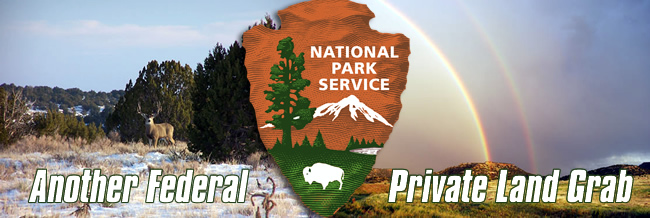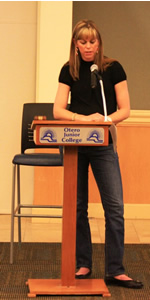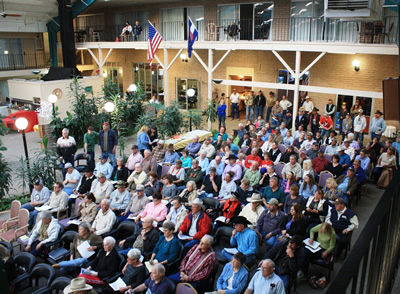
National Heritage Areas
By Norman L. Kincaide Ph.D.
Colorado - A concerned group of about thirty Southeast Colorado farmers, ranchers and residents gathered at the Bent’s Fort Inn in Las Animas, CO on the evening of January 13, 2014 to listen to Bob Parker of Ozarks Property Rights Coalition. The Ozarks Property Rights Coalition successfully stopped a National Heritage Area (NHA) in Missouri and Arkansas. As a result of this meeting Southeast Colorado Private Property Rights Council (SECPPRC) formed on January 30, 2014, providing the residents of the region with an advocate for defending their private property rights, maintaining their local sovereignty and informing the public about and hopefully stopping a NHA proposal for Southeast Colorado.
A November 25, 2013 La Junta Tribune-Democrat article announcing a Gates Family Foundation award of nearly $400,000.00 to Canyons and Plains of Southeast Colorado (C&P), Palmer Land Trust (PLT), Rocky Mountain Bird Observatory (RMBO) and Rocky Mountain Farmers Union (RMFU) prompted the meeting in Las Animas. These organizations with implementation partners, the National Park Service (NPS), The Nature Conservancy (TNC), and Pinon Canyon Expansion Opposition Coalition were going to “create one of the largest protected landscapes in the country” and “establish a national heritage area in Southeastern Colorado.”
Their vision for Southeast Colorado, initially, included eight counties: Baca, Bent, Crowley, Kiowa, Las Animas, Otero, Prowers and Pueblo, totaling more than 10 million acres, later revised to six and a half counties (excluding western Las Animas and all of Pueblo County).
Elisabeth Erickson-NoeResidents of Southeast Colorado, who had never worked together before, joined forces to organize public meetings to present information on how NHAs adversely impact private property and subvert local sovereignty. Crowds continued to grow in size from 50 to 120 to over 200. Editorials were written and published in the local newspapers informing the public of the hazards of NHA designation. A core group of speakers included: Kimmi Lewis, Kim, CO; Ed Hunnicutt, La Junta, CO; Barb Leininger, La Junta, CO; Elisabeth Erickson-Noe, Bent County, CO; and Norman Kincaide, Rocky Ford, CO. SCPPRC also created a website (www.nonha.org) and a Facebook page (go to facebook.com and serach for "Southeast Colorado Private Property Rights Council").
SECPPRC filed a Freedom of Information Act (FOIA) request and documents pertaining to this proposal were received in April. Even before receipt of the FOIA documents there were problems with the NHA process. The executive director of C&P missed meetings with the Bent County Commissioners, Rocky Ford Museum Board and Las Animas County Commissioners. Canyons and Plains published a schedule of community information meetings on March 12, 2014, then cancelled them the next day because of staffing changes, unavoidable circumstances, logistical conflicts, and personal commitments.
Canyons and Plains held one public meeting on April 3, 2014 in Springfield, CO, where executive director of the Park County NHA gave a presentation. Outside of that meeting C&P only presented to elected officials and regional conservation and economic development organizations. The extent of NPS expertise in contributing to this effort was a two-page information sheet about what a NHA is.
Individual SECPPRC county chapters sponsored public meetings in Kim, Pritchett, Walsh, Lamar, La Junta, Ordway, Eads, Las Animas, and Hasty. In May, County Commissioners of Las Animas, Prowers and Kiowa Counties passed resolutions against the NHA proposal, while others were passed by Branson School District, Southern Colorado Livestock Association, Timpas Grazing District, and Rocky Ford Museum Board.
Rocky Mountain Farmers Union (RMFU) and Pinon Canyon Expansion Opposition Coalition, named in the November 25, 2013 Tribune Democrat article and listed by C&P on their Request for Proposal, issued, December 1, 2013, were, in fact, not partners to the NHA proposal.
Ben Rainbolt, Executive Director, RMFU, stated in the La Junta Tribune-Democrat, April 25, 2014 and the AG Journal, May 2, 2014:
“RMFU was not consulted, informed or invited to participate in any discussions to consider forming a national heritage area in Southeast Colorado. We are not a partner, nor do we have a voice in, or support in principle, any projects other than the Land Link initiative. RMFU takes issue with anyone whose writings or comments suggest we are in any way involved in the creation of a national heritage area.”
Cow Palace audience, Lamar, CO, April 17, 2014Neither C&P nor the NPS ever responded concerning this matter. Meanwhile, SECPPRC researchers spoke to over 200 people at the Cow Palace in Lamar on April 17. Back to back sessions in Eads were held on April 30 because the conference room at the Cobblestone Inn could not hold all those wishing to attend. The Senior Center in Ordway on May 12 was packed to standing room only after all the seats were taken.
Canyons and Plains and the NPS had been pursuing this NHA designation since 2007; from The Future of America’s National Parks, First Annual Centennial Strategy for Sand Creek Massacre National Historic Site, August 2007:
“The Sand Creek Massacre NHS works closely with the Southeast Colorado Regional Toruism [sic] Group and in turn the Colorado State Parks Department and the Colorado State Heritage Tourism program to [sic] promote tourism to Southeastern Colorado. The Southeast Colorado Regional Tourism Group is working under a Preserve [sic] America grant to implement a heritage tourism marketing strategy… Currently, the Southeast Colorado Regional Tourism group is working with NPS to look at the possibility of National Heritage Area status for the region.”
Southeast Colorado Regional Tourism Group became Southeast Colorado Regional Heritage Task Force (SECORHT), now Canyons and Plains of Southeast Colorado. Possibly laying the groundwork for the NHA was a heritage tourism report, heritage tourism pilot project, way-finding initiatives, architectural surveys of downtown districts like that of Rocky Ford and surveys of historical assets on private property.
C&P also published a strategic plan April 30, 2008 which stated:
“Residents, business people and elected officials must ‘buy into’ this vision and see it as feasible. Success for the region will depend on present and future leaders promoting this vision.”
Though NHA is not mentioned, a heritage economy is defined: “all of the natural, cultural, historic, and recreational resources that combine for a cohesive, nationally-distinctive landscape. These resources arise from patterns of human activity shaped by geography,” citing the Sierra Business Council. The Blue Ridge NHA website also used this definition. This plan compared Southeast Colorado to the Four-Corners Region as a tourist region. Bent’s Old Fort NHS, however, had only 23,000 visitors in 2013 while Mesa Verde National Park had over 400,000.
C&P and the NPS emphasize that an NHA does not infringe upon private property rights. The NPS, however, uses NHA designations to push its stewardship mission onto private property without having to acquire more park land.
From, Alexa Roberts, The Future of America’s National Parks, First Annual Centennial Strategy for Sand Creek Massacre NHS, August 2007:
“The park is surrounded by privately-owned ranchland. The park is implementing land management strategies within its boundaries that are not currently used by private land owners. . . . Further, the park is maintaining a prairie dog colony because of its contribution to a healthy mixed-grass [sic] prairie mosaic [sic] of diverse plant and animal species, although controversial [sic] with adjacent landowners. The park is slowly establishing relations with neighboring landowners and offering assistance [sic] where possible to highlight these prairie-restoration efforts with the hope that a common land management ethic may one day develop across a broader area, involving federal and private land managers.”
Roberts, Superintendent of Bent’s Old Fort and Sand Creek Massacre site, serves on the Otero County Historic Preservation Advisory Board and Kiowa County Historical Preservation Advisory Commission as well as C&P board. Preservation boards address Section 106 of the Historic Preservation Act of 1966 issues and how land use impacts historic resources and the landscape. The Colorado State Historic Preservation Officer, Dan Corson, suggested that the Kiowa and Otero County boards and Prowers County people have a joint training session on historic preservation during 2014, no doubt in anticipation of greater application of Section 106 over a wider area like a NHA.
Recently, one of the partners downplayed the pursuit of a NHA. Scott Campbell, Executive Director, PLT to J.D. Wright, a local rancher, May 27, 2014:
“Palmer Land Trust is not promoting a National Heritage Area in southeastern Colorado. Nor is any organization. Palmer Land Trust is, however, partner to a locally initiated effort, led by Canyons and Plains to determine whether or not a NHA would serve the interests of southeastern Colorado through a feasibility study.”
While a FOIA document email stated, Oct. 24, 2013, Rick Manzanares, Executive Director, C&P to Greg Kendrick, NPS:
“Yesterday we had a meeting with all the partners to plan immediate and long-term strategies for accomplishing the goals of the grant. All of the partners agreed that we should start the groundwork to pursue a National Heritage Area for the region. . . . We have funding for a feasibility study.”
National Heritage Areas are nothing more than public use covetous on a grand scale benefiting special interest group agendas and a paternalistic NPS. The C&P partnership sought to manage the economic recovery of Southeastern Colorado. Apparently, they couldn’t even manage a campaign to initiate a NHA feasibility study or to effectively respond to “push back.” Maybe the Centennial Strategy for Sand Creek Massacre NHS is indicative; it has numerous typographical errors. Then I had to remind myself: I suppose it’s good enough for government work.
Subscribe to the US~Observer News Flash Alerts!
Subscribe
to the US~Observer |
Get
a subscription to US~Observer delivered
right to your mailbox via first-class mail!
Click Here for more information





 Share
This Article
Share
This Article
